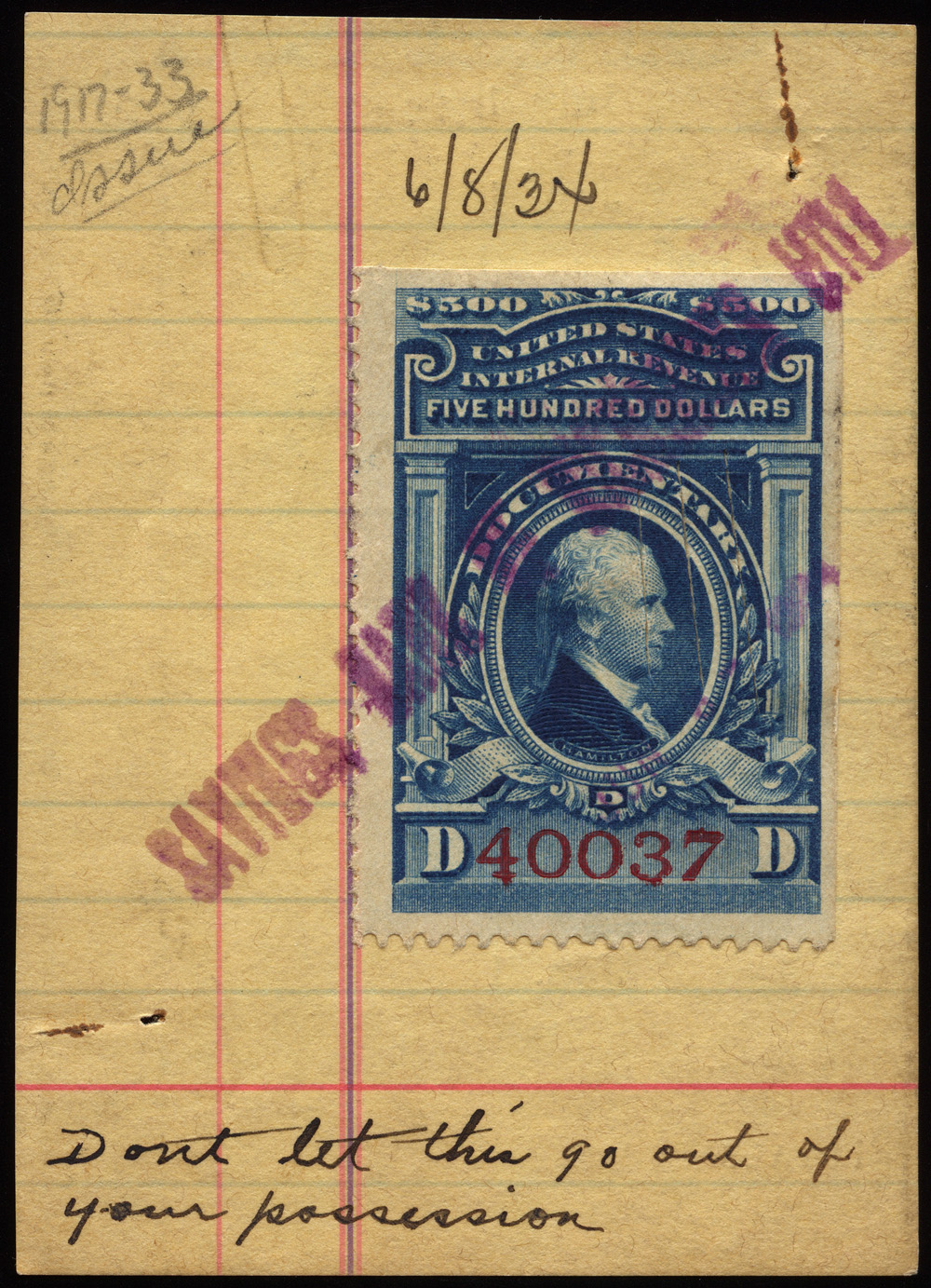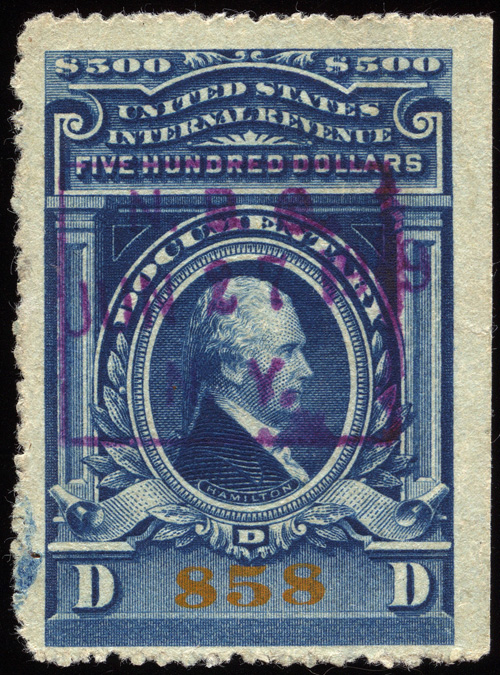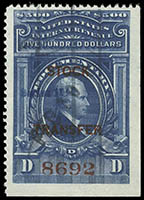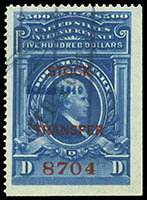The $500 Alexander Hamilton denomination of the 1917 documentary series is such a wonderfully odd duck, in my opinion.

The 1917-1933 documentaries, in addition to serving their documentary purpose, were also overprinted to serve other needs: Future Delivery (RC series in Scott), Stock Transfer (RD), and Silver Tax (RG). Certain denominations were additionally handstamped "Series 1940" in the R, RD, and RG series (although the $500 denomination was not handstamped such in the RG series), these handstamped issues being quite scarce and extremely valuable, not to mention fake handstamps abound.
The $500 denomination occurs with both orange and red serial numbers, differentiated such in Scott. Because certain serial number ranges were only used for certain overprint types, not all types are found with orange serial numbers. The orange serial numbers were only used very early in the serial number range (more on that later).

Here is a summary list of the $500 denominations as currently listed in Scott:
* No orange serial number versions of RD65 or RD65a, as the stamps handstamped were apparently from a very narrow serial number range (bookends #8551-8763 from my limited research) that is well above that where orange serial numbers occurred.
** No orange serial number version of RG22, as the stamps handstamped were from a very narrow serial number range (#40921-41920) that is well above that where orange serial numbers occurred.
For our discussion, the $500 denomination also includes one of the few 20th century major double transfers. It occurs only on the bottom position in a pane (these stamps were printed in panes of four), and does not occur on every pane. Since the DT theoretically exists for all of the above stamp types, it makes for a great item to hunt for. R249, R249a, RC20, RC20a, RD23, and RD23a are relatively findable. However, the base catalog values for the remaining stamps are too high to pursue unless you have deep pockets or get extremely lucky.
I started going down the road of documenting serial numbers intending to determine a pattern as to where double transfers occur. I got part of the way through the process, had an epiphany, smacked my forehead and shouted "Dan, you [CENSORED] idiot!"
Sigh... based upon the printing and numbering processes of the period, there is no way to correlate serial numbers with double transfer panes. Unlike modern large-format presses where numbering is done inline with printing, the numbering would have been performed as a secondary process via letterpress (please correct me if I am incorrect in this assumption).
What this means is that in between when the blue base stamp was printed and the numbering performed, who knows what sheets were stacked/restacked in which order. Additionally, if there were multiple panes per press sheet, if they were cut down prior to numbering, the order in which they would have been stacked could have varied, thus again altering the sequence of sheets/positions. Lastly, if they ran multiple numbering devices in parallel to improve throughput (e.g., station one numbering 1-10,000, station two numbering 10,001 to 20,000, etc.) that too could alter sequencing of panes/sheets if being pulled from the same stock.
So why did I start doing all of this?... Scott # RG22, the silver tax stamp. I noticed that a double transfer is not listed in Scott for RG22, meaning that an actual example had not been reported... but it theoretically should exist... which sent me down this rabbit hole. I started looking for examples online and in auction catalogs... and striking out.
There was extensive discussion about a purported RG22 double transfer back in 2020 regarding lot #2120 in Siegel Sale #1222 on May 29, 2020, where it garnered $649 including BP... not an unreasonable price... if it were genuine. But it isn't. The Philatelic Foundation had mistakenly granted it a good cert, not checking the serial number sequence used for RG22, or they would have noticed that the serial number is well outside of the authentic range of serial numbers for RG22. It's a fake overprint. Subsequent to the sale, the PF contacted Siegel regarding the mistake and the buyer was notified.
(I notice that ALL online records of this cert other than this forum (the PF cert archive, Stamp Auction Network, and the Siegel website) still have not revised any discriptions to reflect that this stamp is bogus. To the unwary collector, this is still claimed to be a genuine stamp, which I find unconscionable.)
When trying to determine how scarce something may be, while the number extant is the most important, the number that could possibly exist is also a factor. As mentioned earlier, RG22 was created from stamps numbered 40921 to 41920, so 1000 total stamps. But the double transfer is limited to the bottom position in the pane, which limits the number to 250 possible... but that assumes that every stamp in that pane position is a DT, which is clearly not the case. So how frequent is the DT (the answer I mistakenly thought deriving a pattern through serial numbers could discern)? If one of every four panes exhibits the double transfer that makes an original population of roughly 60 stamps across the entire RG22 type; if it's one of every eight panes, that means an original population of approximately 30.
Regardless of the exact number originally created, these are absolutely miniscule numbers in the global scheme of things, especially in light of how many of those stamps have likely been destroyed or discarded over the intervening century! Hunting for one is the proverbial needle in a haystack... where someone has lit the stack on fire and burned most of it down (yes, I know... poor analogy as a needle would likely survive the fire and one could sift the ashes for it, but you get my point!
This led me to creating this census page in an attempt to see just how large (or small) a population exists for double transfers on the various $500 Hamilton stamps.
If you have or see any images of $500 Alexander Hamilton double transfers that are not included below, please contact me.
(Click on any of the images below to open the source image in a new window.)
No images or serial numbers yet recorded.




No images or serial numbers yet recorded.